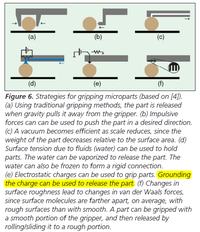CataM
Advanced Member level 4

- Joined
- Dec 23, 2015
- Messages
- 1,275
- Helped
- 314
- Reputation
- 628
- Reaction score
- 312
- Trophy points
- 83
- Location
- Madrid, Spain
- Activity points
- 8,409
I am reading about MicroRobotics in an article from Robotics & Automation Magazine, IEEE.
They are saying that making smaller the objects, then forces created by an Electrostatic field, Magnetic field, Surface Tension of fluids or Van der Waals forces became significant and could be used to manipulate those objects.
They gave me an example but the Electrostatic part I do not understand it very well. I have highlighted that part (see picture).

By "grounding the charge" they are referring to place the object on the ground ? But then I do not understand how the electrostatic field will stop if the "capacitor" is charged...
How an electric schematic for "realising the charge" as they say would look like ?
Is this the electric schematic in figure "e" of the article?

They are saying that making smaller the objects, then forces created by an Electrostatic field, Magnetic field, Surface Tension of fluids or Van der Waals forces became significant and could be used to manipulate those objects.
They gave me an example but the Electrostatic part I do not understand it very well. I have highlighted that part (see picture).

By "grounding the charge" they are referring to place the object on the ground ? But then I do not understand how the electrostatic field will stop if the "capacitor" is charged...
How an electric schematic for "realising the charge" as they say would look like ?
Is this the electric schematic in figure "e" of the article?



